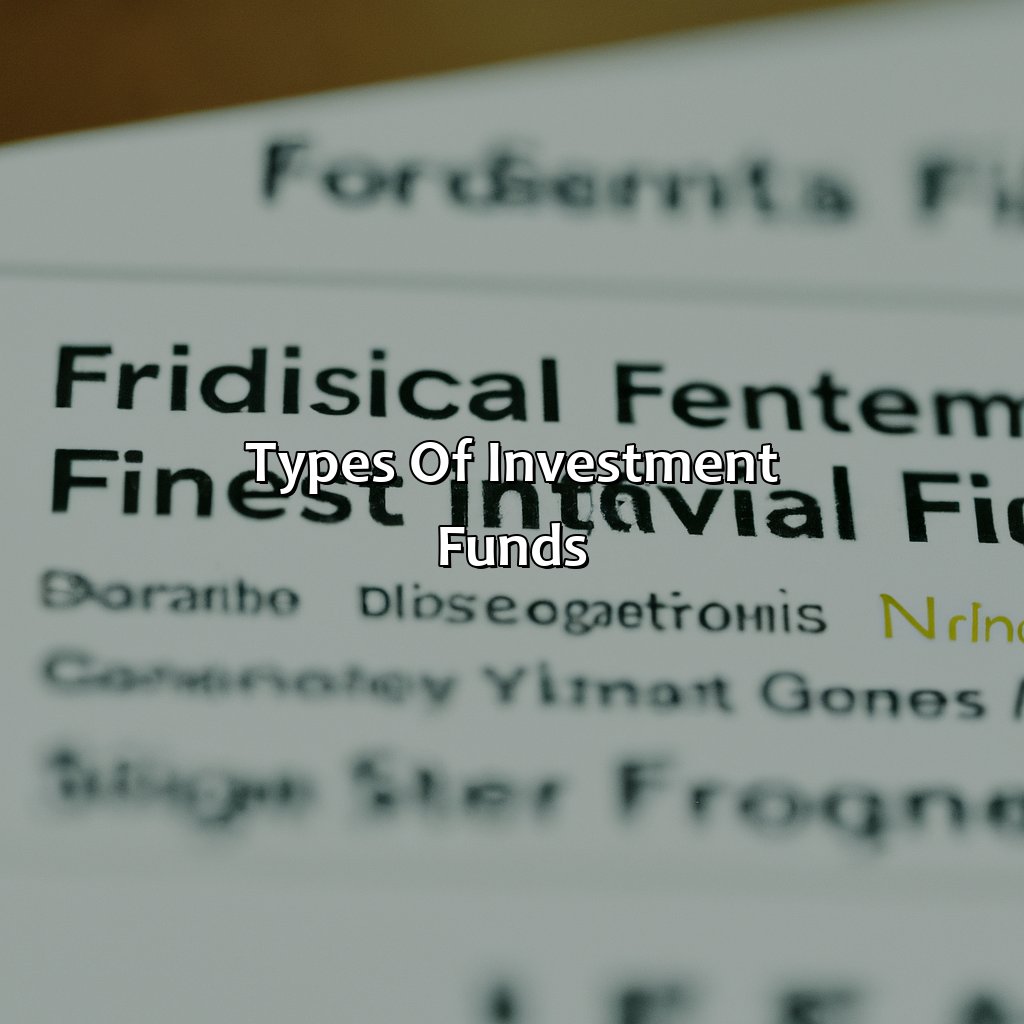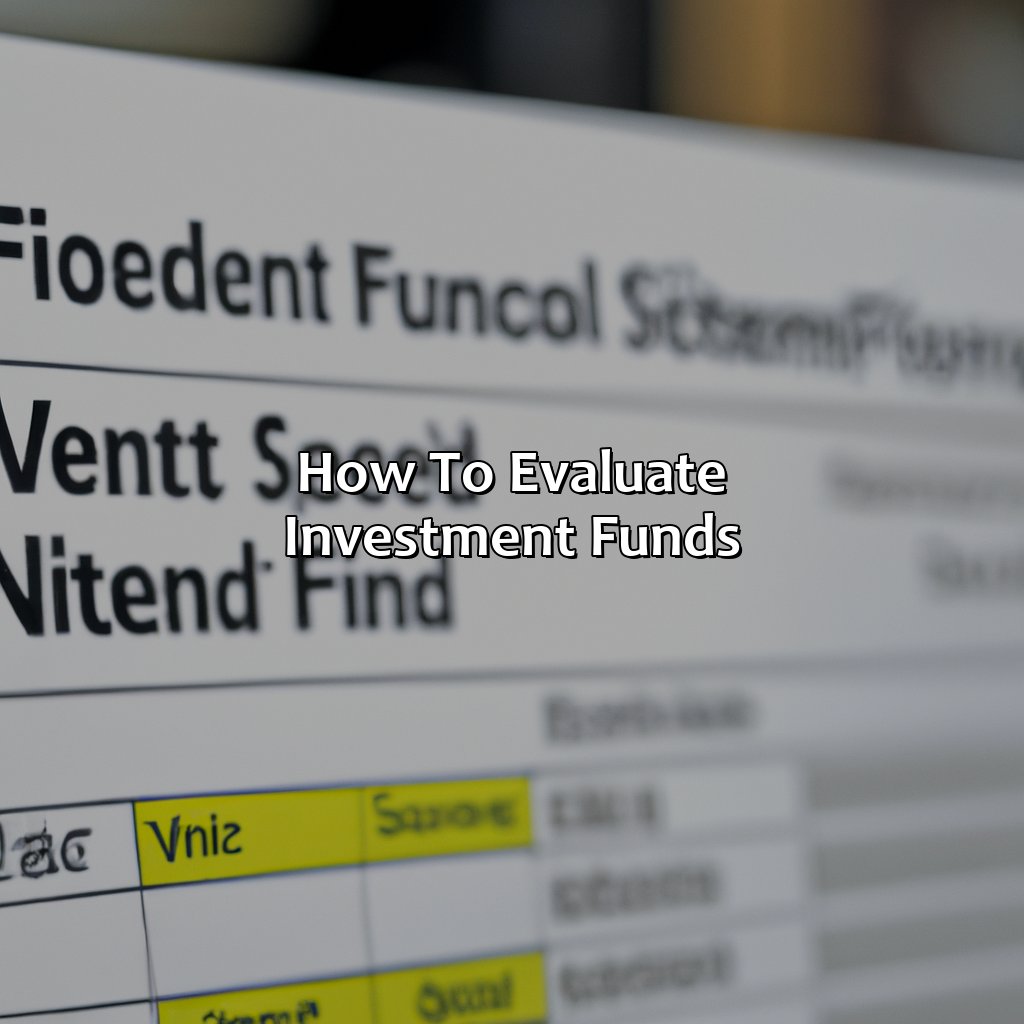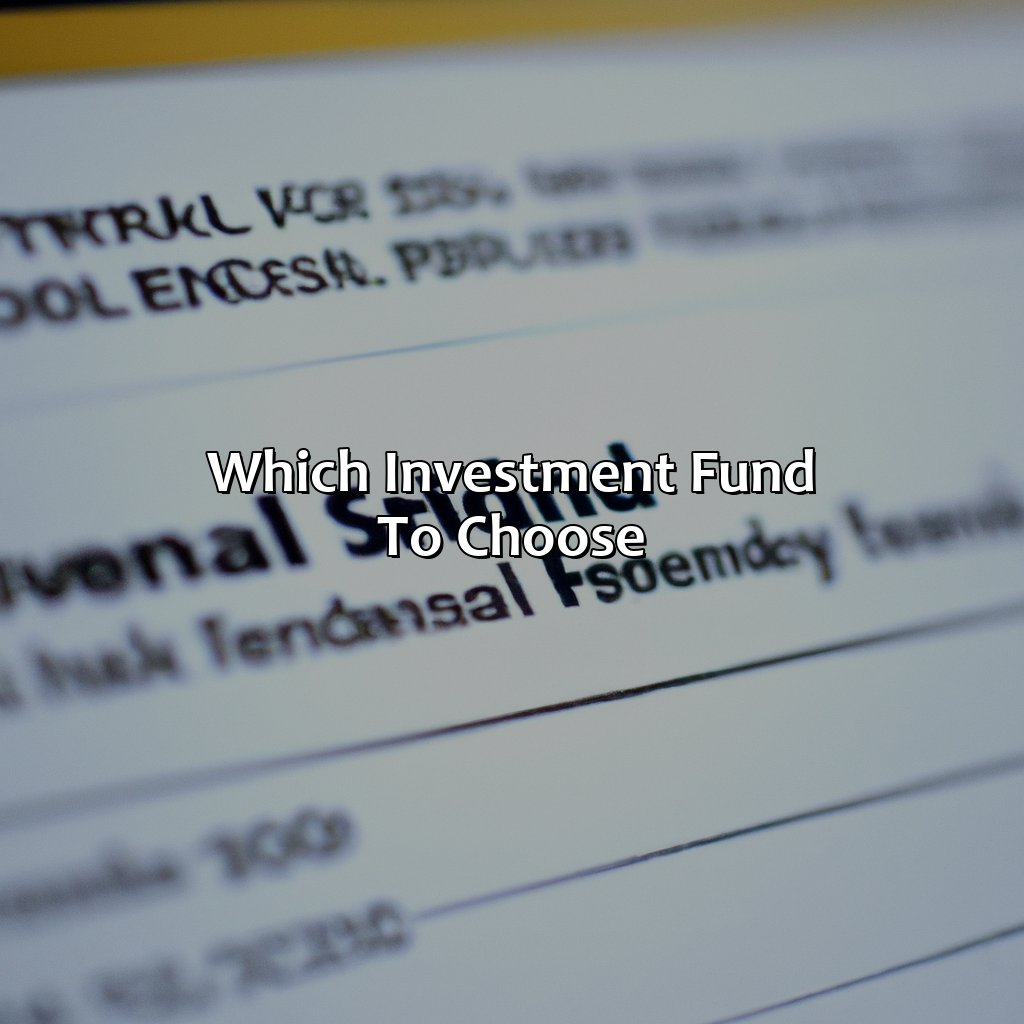Which Investment Fund To Choose?
Key Takeaway:
- Consider your investment goals and risk tolerance when choosing an investment fund. This will help determine which fund type and asset class is best suited for your needs.
- When evaluating investment funds, pay attention to fund performance and manager experience. Additionally, consider the expense ratio and fees, as well as historical and prospective returns, to ensure the fund is worth investing in.
- Diversification is key. Look for funds with a diversified portfolio and fund holdings to minimize risk and maximize returns.
Are you in search of the perfect investment fund to meet your needs? Then, you have come to the right place! This article will provide an extensive guide on choosing the right investment fund for you. We’ll cover the different options, features, and risk factors to consider.
Factors to Consider when Choosing an Investment Fund
Take these into account when selecting the right fund for you:
- Investment Goals and Risk Tolerance
- Fund Type and Asset Class
- Fund Performance
- Manager Experience
Weigh these factors carefully. This will help you pick the fund that suits your investment objectives and preferences. Make a wise decision on investing in a fund!

Image credits: retiregenz.com by David Jones
Investment Goals and Risk Tolerance
Investment objectives and ability to withstand risk should be the primary determinants when choosing an investment fund. Understanding your goals, such as long-term growth or short-term income, and assessing your tolerance for market fluctuations is crucial in selecting a suitable fund.
Moreover, it is also essential to identify what level of diversification and asset allocation makes sense for you. This involves considering factors like age, income level, investment knowledge, and existing portfolio composition.
Remember that selecting the appropriate investment fund can significantly impact your returns. Therefore, it is advisable to conduct proper research by reading through the prospectus, evaluating past performance history and comparing fees across various funds before choosing.
By taking time to consider your investment objectives and risk appetite when selecting an investment fund that aligns with those objectives can prove successful in achieving financial stability and avoiding potential losses. Make sure not to miss out on this opportunity by making an informed decision today!
Choosing a fund type and asset class is like deciding between a healthy salad or a greasy burger – both have their benefits, but only one will lead to long-term satisfaction.
Fund Type and Asset Class
When selecting an investment fund, it is crucial to consider the type of funds and the asset class they represent. The combination of these two factors can help determine whether a particular investment option aligns with your investment objectives and risk tolerance.
Fund Type and Asset Class can significantly influence the performance of your investments. Here is a table that summarizes different types of funds and the various asset classes they cover:
| Type of Fund | Asset Classes Included |
|---|---|
| Index Funds | Equities and Fixed Income |
| Mutual Funds | Equities and Fixed Income |
| Hedge Funds | Alternative Investments |
It’s noteworthy that different funds offer diverse levels of risk, return, and liquidity. Index Funds represent low-cost options gaining profits similar to market trends without a high degree of risk. On the other hand, Mutual Funds investments require advice from financial experts due to their higher risks portfolio but also show distinct potential returns.
Make sure you avoid missing out by getting started on investing today! Understanding Fund Type and Asset Class will help lead you in making informed decisions to embrace long-term success in investing.
When it comes to investment fund managers, experience may not always guarantee success, but it sure does make for some entertaining stories at the next cocktail party.
Fund Performance and Manager Experience
Investment Fund Performance and Manager Experience are crucial considerations when investing. Let us explore some factors to consider when selecting an investment fund.
| Factor | Description |
|---|---|
| Fund Performance | Analyze the historical performance of the fund and check its returns over different periods of time. |
| Manager Experience | Check the track record of the manager, their investment style and their experience in dealing with similar funds or sectors. |
It is imperative to note that choosing an investment fund solely based on its past performance may not be wise. Other crucial factors include management costs, liquidity, risks involved and the current market conditions.
To select an appropriate investment fund, you should ensure that it aligns with your financial goals, risk tolerance and overall investment strategy. Diversifying across asset classes and avoiding unnecessary exposure to any one security can help spread risk.
Why put all your eggs in one basket when you can put them in multiple investment funds? Diversify or die trying.
Types of Investment Funds
To grasp the various kinds of investment funds, you need to understand their specializations. Pick an investment fund that meets your requirements by exploring Equity Funds, Fixed Income Funds, Multi-Asset Funds, Index Funds and ETFs. Every one of these subsections provides distinct solutions.

Image credits: retiregenz.com by James Washington
Equity Funds
Equity funds are a type of investment fund that primarily invests in stocks or shares of companies. These funds provide investors with exposure to the equity markets and potential long-term capital appreciation. Equity fund managers aim to identify profitable opportunities within various sectors, industries, and geographical regions to generate higher returns for investors. They may have different styles of investment, such as growth, value or blended. Equity funds are popular among those seeking high return potential but are willing to bear moderate risks.
In addition to individual stock selection, equity fund managers may also take advantage of trend analysis, fundamental analysis, and economic forecasts while investing. Equity funds can be further classified into several categories based on their investment strategy, sector focus and market capitalization. Some examples include large-cap equity funds, mid-cap equity funds, small-cap equity funds or index-based equity funds.
Investors need to consider their investment goals and risk appetite before selecting an appropriate equity fund for their portfolio. Those looking for greater diversification should choose several types of equity funds that will complement each other and reduce overall portfolio volatility while enhancing returns.
Pro Tip: Investors should regularly review the performance of their chosen equity funds against indices like S&P 500 Index or MSCI World Index and rebalance their portfolio if necessary.
Fixed income funds – the perfect investment for those who love getting a steady stream of income and watching paint dry at the same time.
Fixed Income Funds
Investment vehicles that allocate pooled resources towards investments in debt securities are called Debt funds. These funds aim to generate fixed income and provide capital preservation to investors with relatively lower risks. The fixed-income funds are suitable for conservative investors seeking low-risk investments with regular cash flows.
These types of debt funds mainly invest in bonds, both government and corporate, deposits, money markets, etc., with their investment portfolios being managed by professionals. The amount of returns received by an investor primarily depends on the underlying assets’ credit rating and duration. Longer-term bonds usually yield higher while shorter-term bonds yield lower returns.
Investors can choose different types of Fixed Income Funds like Government Bond Schemes- investing only in government-issued bonds; Corporate Bond Funds- investing in debt securities issued by companies; Short term bond funds – having a maturity period of up to three years.
According to Morningstar, an investment research company, Fixed Income Funds saw record inflows during the first quarter of 2021 despite rising inflation fears. Why choose one asset when you can have them all? Multi-asset funds: the investment equivalent of a buffet.
Multi-Asset Funds
Investment Funds with a Diverse Portfolio
An investment portfolio that spans several asset classes and sectors is often called a multi-asset fund. Multi-asset funds select optimal combinations of different types of securities to reduce risks and increase returns. The allocation strategies, such as stocks, bonds, real estate, or alternative investments, are diverse in their composition and proportionate weights. These funds allow investors to benefit from diversification while reducing concentration risk. Some multi-asset funds may also be categorized by geographic regions or industries. For example, emerging market-focused investing can provide exposure to companies in countries like China or Brazil, which aren’t widely represented in developed markets.
Multi-Asset Funds have become increasingly popular as they offer an all-in-one solution for diversified investment holdings. Investors would find it beneficial to assess if these funds align with their financial goals before making any investment decisions.
One suggestion when it comes to investing in Multi-Asset Funds is identifying the Weighted Average Maturity (WAM) component since holding longer-term fixed-income securities results in greater interest rate exposure compared to holding shorter-term securities. Thus, selecting a suitable multi-asset fund with an appropriate WAM can help meet your specific needs.
If you want to invest in boring but reliable stocks, choose index funds and ETFs- because nothing screams excitement like diversification.
Index Funds and ETFs
Investment funds that track an index and are traded like stocks in the market are a popular choice for investors. These types of funds provide diversification and low expense ratios. They are known as passive investment options, as the aim is to match the performance of a specific benchmark.
Index Funds and ETFs offer investors exposure to various stocks or indices, providing a simple and cost-effective way to invest for long-term growth. Index funds work by investing in all, or a large number of, stocks in a particular index. On the other hand, ETFs combine the ease of trading stocks with the portfolio diversification benefits of mutual funds.
Index funds are managed passively, without any active buying or selling based on market conditions. In contrast, ETFs allow investors to buy or sell at any time during normal trading hours as they trade like shares on stock exchanges.
Investors should consider their investment goals when choosing between these two options. Index funds generally have lower fees than ETFs but may not offer instant trading capabilities.
It is suggested that novice investors who want easy-to-use portfolios with broad holdings should consider investing in index funds. However, more experienced investors who prefer flexibility and access to intraday trading might find ETFs more suitable for their needs. Both investments can produce stable returns over time if chosen wisely after considering personal circumstances and financial goals.
Eval-u-8ing investment funds sounds like a math problem, but it’s really just a matter of digging through piles of financial jargon and hoping for the best.
How to Evaluate Investment Funds
Examining Investment Funds? Evaluate with Expense Ratio and Fees. Also, view Historical and Prospective Returns. Additionally, Fund Holdings and Portfolio diversification should be assessed. This is essential for choosing the right Investment Fund. Carefully analyze each factor before deciding!

Image credits: retiregenz.com by Joel Duncun
Expense Ratio and Fees
Investment Fund Costs – An Evaluation
To make informed investment decisions, prospective investors must understand the various costs associated with investing in funds. This includes expense ratios and fees.
| Fund | Expense Ratio | Front-End Load Fee | Back-End Load Fee | Management Fee | Other Fees |
|---|---|---|---|---|---|
| Vanguard 500 Index Fund Admiral Shares (VFIAX) | 0.04% | N/A | N/A | $0.02 per $1,000 invested annually (maximum of $20/year) | $20 for account management or exchange fee for non-Vanguard funds. |
Looking beyond expense ratios, it’s essential to consider other unique details such as turnover ratio, tax implications, and minimum investment requirements when evaluating different funds.
It’s advisable to diversify investments across multiple asset classes instead of focusing on a single category. Investors should also avoid chasing past performance and focus on the long-term potential of the chosen funds. Based on individual preferences, investors may opt for passive or active management strategies. Carefully evaluating these factors will help select better-performing investment options that match investor goals and constraints.
Looking back is great for nostalgia, but when it comes to investment funds, it’s the future returns that really count.
Historical and Prospective Returns
Investment Funds Analysis: Past and Prospective Gains
Historical and Prospective Returns are a crucial element to consider when evaluating an investment fund. It involves examining the fund’s previous investment performance along with its potential future earnings.
To magnify this analysis of Historical and Prospective Returns, let’s take a look at a table that showcases the historical returns and expected future gains of two different investment funds.
| Fund Name | 5-year Annual Return | 10-year Annual Return | Potential Future Gains % |
|---|---|---|---|
| Fund A | 12.7% | 14.2% | 9-11% |
| Fund B | 11.3% | 12.7% | 8-10% |
Observing the table above, we can ascertain that both investment funds earn remarkable returns over the past five and ten years – making them good options for prospective investors.
In addition to Historical and Prospective Returns, it is significant to analyze other aspects of funds such as: Expense Ratios, Asset Allocation, Investment Philosophy, Reputation of manager/advisor, among others.
If you’re looking for some advice before selecting an investment fund, consider these suggestions:
- Look for low expense ratios as these can significantly affect your net returns.
- Analyze asset allocation in comparison with your financial goals.
- Evaluate the expertise and philosophy of managers by studying their related experience.
By considering these parameters alongside Historical and Prospective Returns will help you determine which fund is suitable to invest in, while minimizing risks.
Fund Holdings and Portfolio diversification
Investment Management & Risk Aversion analysis is an essential step in selecting investment funds. Understanding how fund holdings and portfolio diversification reduce financial risks is vital. Careful analysis of these factors can help investors identify the potential long-term performance of investment funds. It’s important to consider factors like concentration risk, diversification across sectors, market caps and geographies, asset class allocation and sustainability characteristics.
Diversifying into multiple holdings with distinct management strategies can lead to better risk-adjusted returns. Investors should examine their level of risk tolerance before venturing into different investment opportunities. Investing in a diverse set of securities will insulate investors from frauds or manipulations such as insider trading schemes that could affect a single security heavily.
By benchmarking the portfolio’s standard deviation against that of the market – using the Sharpe ratio, for instance – one can gauge its efficiency and potential to generate surplus returns when compared against systematic alternatives. Optimizing your portfolio assets based on this criterion helps better project future returns.
Pro Tip: When investing, aim for different sectors with low correlation coefficients than each other. This methodology reduces systematic risks associated with investing and promises superior overall returns over time.
Some Facts About Choosing an Investment Fund:
- ✅ Investment funds are an easy and convenient way for individual investors to gain access to a diversified portfolio of assets. (Source: Investopedia)
- ✅ There are different types of investment funds available, such as mutual funds, exchange-traded funds (ETFs), and index funds, each with its own unique features and benefits. (Source: The Balance)
- ✅ One should consider factors like the fund’s expense ratio, performance history, management team, and investment strategy when choosing an investment fund. (Source: Forbes)
- ✅ It is important to diversify investments across multiple funds and asset classes to reduce risk and improve returns. (Source: Investopedia)
- ✅ Working with a financial advisor can help individuals make informed investment decisions and create a personalized investment plan. (Source: NerdWallet)
FAQs about Which Investment Fund To Choose?
How do I decide which investment fund to choose?
Choosing an investment fund can be overwhelming to a beginner. However, you need to consider your risk tolerance, investment goals, and financial situation before making a decision. Additionally, you have to research the track record of the fund, its expense ratio, and management fees before committing your money.
What is the difference between mutual funds and index funds?
Mutual funds and index funds are both investment vehicles, but they differ in their investment strategies. Mutual funds are actively managed by experienced fund managers, who buy and sell stocks and bonds with the aim of outperforming the market. On the other hand, index funds track a specific market index, such as the S&P 500, and have lower fees because they require less active management.
What should I look for when reviewing fund performance?
When reviewing fund performance, consider the fund’s benchmark index, the time period of comparison, and consistency in its performance. Also, consider the standard deviation and other risk indicators when comparing returns.
What is an Expense Ratio?
An expense ratio is the annual fee charged by a fund to cover its operating expenses. This fee is expressed as a percentage of the fund assets. Mutual funds generally have higher expense ratios than index funds, which have lower operating expenses.
What is the best way to diversify investments across multiple funds?
The easiest way to diversify investments is to invest in a few different mutual funds and index funds that represent different sectors or asset classes. Another option is to use target-date funds, which automatically diversify the investment portfolio based on the investor’s age and investment goals.
What factors can affect the growth rate of an investment fund?
The growth rate of an investment fund is affected by factors such as the fund’s management team, the economy, market volatility, and investment strategy. Additionally, a fund’s asset allocation and expense ratio can also impact its growth rate over time.


